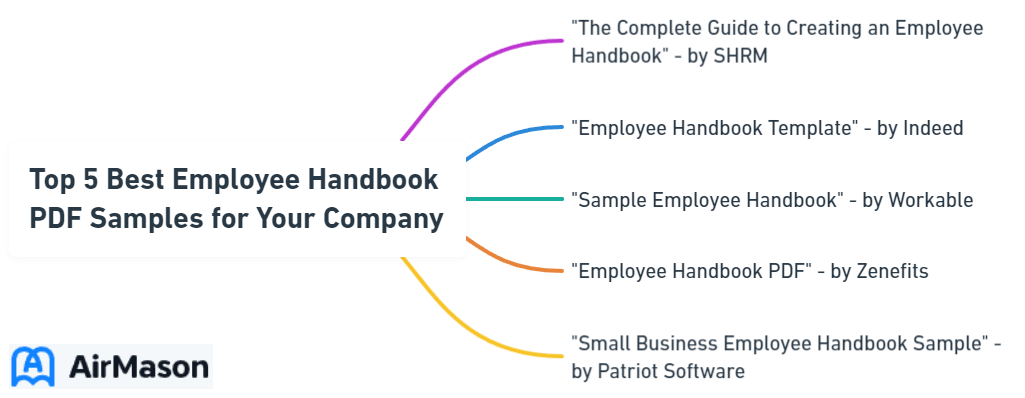
What sets the best employee handbook pdf apart from the rest? Clarity, engagement, and a tailored approach that resonates with company culture. Discover efficient handbook examples from major industries and learn how the pros craft documents that both instruct and inspire. Dive in for a clear-cut selection of the most effective handbooks available, ready to guide your company to its next chapter.
Key Takeaways
- Employee handbooks should be tailored to represent the unique cultures, policies, and needs of different types of organizations, from innovative tech companies to traditional corporate businesses, small startups, nonprofits, and retail chains.
- An effective employee handbook should cover universal elements such as the company’s mission and values, employment policies and procedures, compensation and benefits, and workplace conduct and ethics to ensure clarity and alignment between employer expectations and employee behavior.
- Employee handbooks should be customized to reflect industry-specific challenges and company culture, be regularly updated to remain relevant, and utilize digital, visually appealing, and interactive formats for enhanced accessibility and engagement.
Top Employee Handbook PDF Examples

Handbooks are not one-size-fits-all. They should be as diverse as the companies they represent. From innovative tech firms to traditional corporate businesses, small startups, nonprofits, and retail chains, each type of organization requires a unique approach to its handbook.
Let’s explore some of the top examples that have mastered the art of creating an effective and engaging handbook, using one of them as an example.
Innovative Tech Company
When it comes to innovative tech companies, the employee handbook is not just about policies and procedures. It’s a blend of creativity, inspiration, and company values. Consider Meta, their handbook is an art piece, filled with visual elements that not only inform but inspire and motivate their employees about the company’s commitment to speed and innovation.
On the other hand, Valve Software takes a different approach, using humor and comic strips in their employee handbook to effectively communicate the company’s unique culture and expectations. The primary values are illustrated through artwork and comic-format guides, demonstrating the company’s commitment to innovative communication methods. Both these companies know how to establish a compelling and memorable company culture through their handbooks.

Traditional Corporate Business
On the other end of the spectrum, traditional corporate businesses like Wells Fargo emphasize clarity and professionalism in their handbooks. The handbook is designed to provide comprehensive support features for easy navigation, including:
- An 11-page glossary
- Charts
- Annotations
- Links to relevant account information
These elements ensure that employees have a clear understanding of their roles and responsibilities, and they know where to find answers to their questions.
This type of handbook may not be as visually appealing as those found in tech companies, but they serve a crucial role in providing clear and concise information to employees, ensuring that they understand the company’s expectations and their role within the organization.
Small Business Startup
Small business startups are often characterized by their flexibility and innovative approaches to traditional business practices. Their handbooks reflect this entrepreneurial spirit, showcasing adaptive and responsive policies to meet the dynamic needs of the workforce.
Moreover, a small business startup handbook emphasizes:
- Personal and professional growth opportunities aligning with the company’s development goals and entrepreneurial character
- Setting the stage for employees to understand the company’s growth mindset
- How employees can contribute to and benefit from the company’s growth
Nonprofit Organization
Nonprofit organizations have a unique focus in their handbooks – their mission and values. These handbooks instill a sense of purpose and guide staff behavior, emphasizing the significance of their work. They also include specific volunteer management policies, outlining the essential role of volunteers and how staff should work with them.
A commitment to work-life balance is commonly emphasized, acknowledging staff dedication and the importance of personal well-being. Also, their handbooks often feature generous leave policies, such as community service leave, to enable employees to contribute to charitable causes.
Retail Chain
In retail chains, the handbook serves a crucial role in emphasizing the high importance of customer service, as it directly impacts the customer experience and business success. The handbook should include specific policies on customer service standards and guest interactions to ensure consistency and quality across all retail locations.
This emphasis on customer service ensures that all employees, regardless of their location or position, understand the company’s commitment to providing a high-quality customer experience.
Sample Employee Handbook PDF
Looking for a comprehensive guide to crafting your company’s employee handbook? A sample employee handbook PDF can provide valuable insights and templates to kickstart the process. These documents typically cover a range of topics, including company policies, employee benefits, code of conduct, and procedures. By accessing a sample employee handbook PDF, businesses can save time and effort in creating their own customized handbook tailored to their specific needs and industry standards. Additionally, reviewing various sample handbooks can help organizations ensure they address essential topics and comply with relevant regulations. With the right sample employee handbook PDF as a reference, companies can establish clear guidelines and expectations for their employees, fostering a productive and harmonious work environment.
Essential Components of an Effective Employee Handbook

Whether a tech giant, a traditional corporate business, or a small retail store, there are some universal elements that every effective employee handbook should cover. These include:
- The company’s mission and values
- Employment policies and procedures
- Compensation and benefits
- Workplace conduct and ethics
Let’s delve into each of these components to understand their significance and how they contribute to an effective handbook.
Company Mission and Values
The company’s mission, vision, and values lay the foundation of any successful employee handbook. They establish what the company stands for, the success it seeks to achieve, and the principles guiding behavior and decision-making.
These elements should be created with engagement from all company levels, ensuring that everyone has a stake in the overarching goals and principles. It’s not enough to merely state these values; they must be lived out through the company’s daily operations and decisions to prevent them from becoming empty promises.
Including the mission statement in the employee handbook provides a sense of purpose and creates a rallying point for employees to align their work with the company’s larger objectives.
Employment Policies and Procedures
Clear and comprehensive employment policies and procedures are the backbone of any employee handbook. They define the company’s approach to various workplace topics including hiring, performance, and termination procedures, ensuring that both employees and employers are on the same page.
Performance expectations are communicated through policies on topics such as dress code, internet and device security, conflict of interest, and workplace relationships. Termination procedures must be well-defined, indicating the steps for handling progressive discipline, employee resignation, termination processes, and policies on providing references for former employees upon request.
These guidelines ensure that all employees are clear about what’s expected of them and the consequences of non-compliance.
Compensation and Benefits
Transparency and clarity are key when communicating and discussing compensation and benefits. Details about salary, bonuses, performance reviews, and benefits packages should be well-documented in the employee handbook.
For exempt employees, compensation must be calculated based on an annually calculated salary. It’s also important for employees to understand their entitlements to government benefits as per federal and state laws. For small startups with limited resources, clear information on policies regarding overtime compensation and distinctions between part-time and full-time roles can help manage expectations and prevent confusion.
Workplace Conduct and Ethics
Every employee handbook should include a clear code of conduct, outlining the ethical framework and behavioral expectations for employees. This should cover areas such as:
- Dress code
- Cybersecurity
- Conflicts of interest
- Relationships at work
The handbook should detail the following:
- Clear anti-discrimination policies mirroring federal anti-discrimination laws
- Definition of unwelcome sexual conduct as harassment
- Guidelines on appropriate sharing of content on social media
- Workplace safety and health policies, ensuring that employees are well-versed in measures against health crises and data security threats.
Employee Handbook Contents
When it comes to crafting an effective employee handbook, the selection of appropriate “employee handbook contents” is crucial for providing comprehensive guidance to your workforce. These contents serve as the foundation for outlining company policies, procedures, and expectations, ensuring clarity and consistency across all levels of the organization. Typically, an employee handbook includes sections covering topics such as company mission and values, employment policies, code of conduct, benefits, and disciplinary procedures. Additionally, it may incorporate specific guidelines related to workplace safety, diversity and inclusion, and employee rights and responsibilities. By meticulously curating these contents, organizations can foster a positive work environment, mitigate potential conflicts, and empower employees with the necessary information to thrive within the company culture.
Customizing Your Employee Handbook
While there are universal components that every employee handbook should include, it’s important to remember that your handbook should also be a reflection of your company. It should address the unique challenges and regulations specific to your industry, reflect your company culture, and be updated regularly to maintain its relevance and effectiveness.
Tailoring Content to Your Industry
Every industry has its unique challenges and regulations. Therefore, your employee handbook should address these aspects to ensure it is relevant and compliant. For instance, a tech company’s handbook may need to delve into data privacy and security policies, while a retail chain might need to specify customer interaction standards and inventory management procedures.
Tailoring your handbook to your industry not only ensures that your employees understand industry-specific expectations and guidelines but also helps your company stay compliant with industry regulations and standards, thereby minimizing potential legal issues.
Reflecting Company Culture
Your employee handbook is a reflection of your company culture. It should infuse your organization’s unique values, mission, and operational style to create a cohesive and engaging reader experience. Whether it’s Valve’s comic format or the National Federation of Independent Business’s family values, each handbook tells a story about the company’s culture.
Incorporating the company’s history and purpose into the handbook’s conclusion can inspire new employees and share the company culture and values in a compelling narrative form. Not only should the handbook reflect company culture, but it should also serve as a tool to enhance employee engagement and communicate pertinent policy updates.
Updating the Handbook Regularly
The world we live in is dynamic, and your employee handbook should be too. Regular updates to your handbook ensure it remains current and comprehensive. Whether it’s new industry regulations, changes in company policies, or the introduction of new technology and training methods, your handbook should reflect these changes.
These updates should not only provide legal protection from lawsuits and audits but should also reflect ongoing changes in the industry and company, including new technology and training methods. With the rise of cloud-based employee handbook software, updating has become increasingly easier and more efficient, contributing to effective employee engagement and shaping of company culture.
Creating an Accessible and Engaging Employee Handbook

While content is king, the way it’s presented can make all the difference. In a digital age, your employee handbook should be accessible, visually appealing, and interactive, ensuring a smooth event for employees navigating through the present handbook.
Let’s explore how digital formats, visual design, and interactive elements can enhance your handbook.
Digital Formats and Platforms
Digital handbooks offer numerous advantages over traditional printed ones. Storing your handbook in the cloud allows for central content management and ensures that information is consistent across the company.
Moreover, cloud-based digital handbooks can be accessed from anywhere with an internet connection, providing flexibility and remote access for employees. This means that whether your team is working from the office, home, or even another country, they can easily access the information they need.
Visual Design and Layout
Visual design and layout play a crucial role in making your employee handbook user-friendly and visually appealing. Use color, typography, and consistent branding to create an engaging layout. Also, ensure your layout is intuitive and user-friendly with a clear table of contents, headers, and subheaders to help employees find information quickly.
Incorporating storytelling techniques like humor and compelling visuals can make the content more understandable and memorable. Learn from historical handbooks like Disney’s 1943 employee handbook and Zingerman’s Staff Guide, which set benchmarks for creativity.
Interactive Elements
Interactive elements can greatly enhance employee engagement with the handbook. Multimedia content such as videos or audio clips can provide a richer, more engaging experience for readers. Incorporating quizzes and assessments into the digital employee handbook can help reinforce understanding of key policies and procedures.
Interactive feedback channels, including surveys, comment sections, or suggestion boxes, can be implemented in digital handbooks to encourage employee participation. This not only makes your handbook more engaging but also creates a two-way communication channel, allowing you to receive valuable feedback and insights from your employees.
Summary
We’ve explored how to create an effective and engaging employee handbook, from understanding the basics, customizing it to your industry, reflecting your company culture, to making it accessible and interactive. Remember, your handbook isn’t just a document; it’s a powerful tool that shapes your company culture, guides employee behavior, and helps foster a productive and harmonious work environment. So go ahead, breathe life into your employee handbook and let it be a true reflection of your organization’s spirit and values.
Frequently Asked Questions
How to write employee handbook?
When writing an employee handbook, include key sections such as introduction, workplace commitments, company policies, employment classification, attendance policies, leave policies, work performance, and discipline policy. It’s important to gather feedback and ensure that the policies reflect the company’s values.
What is the better name for the employee handbook?
Consider renaming the employee handbook to Employee Guide, Employee Manual, or Employee Playbook. These alternatives can better reflect the content and purpose of the document.
What every employee handbook should have?
Every employee handbook should include a welcome letter, company introduction, EEOC statement, and comprehensive workplace policies covering hiring, attendance, payroll, breaks, paid time off, cybersecurity, privacy, and anti-discrimination. This provides essential information for new and existing employees.
What should be avoided in an employee handbook?
It’s important to avoid topics like using the handbook to control outcomes, making policies too complex, and missing the intent. Also, don’t forget to include legally obligated policies and information on leaving the company.
What makes an employee handbook effective?
An effective employee handbook should cover the company’s mission, values, policies, and workplace conduct, while also reflecting the company’s unique culture and being regularly updated to stay relevant. Regular updates and customization are important to ensure its effectiveness.
Disclaimer:
Please be aware that the content on this page has been generated by using artificial intelligence language models and may contain errors, inconsistencies, or outdated information.
It is provided as-is without any warranties or guarantees of accuracy. We strongly recommend using this content as a starting point for further research. We disclaim any liability for damages or losses resulting from the use or reliance on this content.